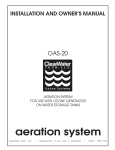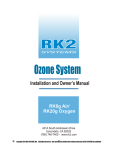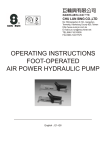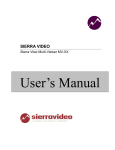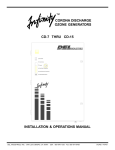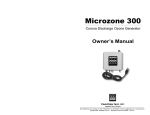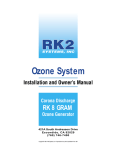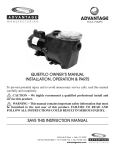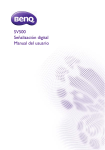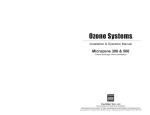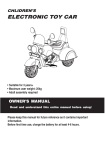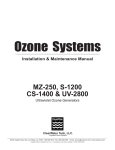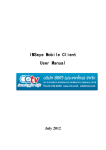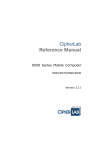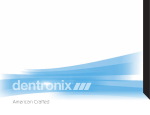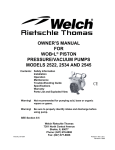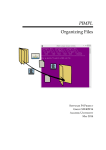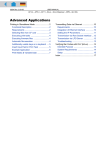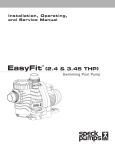Download CD20/02 manual - US Water Systems
Transcript
T E C H, L L C . Ozone Systems Ozone System CD-20/O2 Corona Discharge Ozone Generator Installation & Owner’s Manual P.O. BOX 15330, San Luis Obispo, CA 93406 Copyright © 1994 - ClearWater Tech, Inc. • Reproduction of any kind is prohibited • Rev. 10/00 2 IMPORTANT SAFETY INSTRUCTIONS 1. PLEASE FOLLOW ALL INSTALLATION INSTRUCTIONS. 2. All plumbing connections should be made by a licensed, qualified plumber. 3. All electrical connections should be made by a licensed, qualified electrician. 4. Before attempting any electrical connections, be sure all power is off at the main circuit breaker. 5. Install the provided ozone check valves to prevent water from contacting the electrical equipment. 6. The electrical supply for this product must include a suitably rated switch or circuit breaker to open all ungrounded supply conductors to comply with Section 422-20 of the National Electrical Code, ANSI/NFPA 70-1987. The means of disconnecting the equipment must be readily accessible to the operator(s). 7. Be sure to bond (ground) the system using the copper bonding lug on the bottom of the components. The system should be bonded with solid copper wire conforming with all local, state and national electrical codes. 8. Ambient temperature around the equipment should be between 40° and 100°F (4.5° to 38°C). If the equipment is installed in an environment with temperatures over 100°F, additional air cooling must be provided. Installation without additional air cooling in an environment where temperatures exceed 100°F for any continuous 24 hour period will void the warranty. 9. The system should be sized appropriately for its intended use by a qualified professional familiar with the application. This equipment must be validated by the manufacturer for its intended use. 10. SAVE THESE INSTRUCTIONS. 3 CORONA DISCHARGE (CD) OZONE SYSTEMS Ozone is manufactured in the CD ozone generator by drawing in air, which is composed of 20% oxygen (O2), and exposing it to multiple high voltage electrical discharges. This causes a percentage of the oxygen molecules to dissociate and reassemble as ozone (O3). The ozone is drawn into the water by an injector/mixer, killing any bacteria, viruses or mold spores it contacts. Ozone is generated on-site, eliminating the need to store toxic and corrosive chemicals. The corona discharge method is the most efficient way to produce large amounts of ozone. 3 - O2 2 - O3 Chemical Formula (simplified) for Corona Discharge Ozone In contrast to ultraviolet ozone generators, corona discharge systems produce a much higher concentration of ozone and in much larger quantities. In addition, the annual expense of replacing lamps and checking ballasts is unnecessary with corona discharge systems. Corona discharge ozone generation is the most economical and effective method to use on most water treatment applications. ClearWater Tech manufactures high output corona discharge systems capable of producing enough ozone to oxidize iron, sulfide, manganese and act as an efficient sanitizer in a variety of applications. Ozone reacts to water-borne contaminants significantly faster than other disinfectants and the primary by-product is pure oxygen. ClearWater Tech ozone systems are built with the finest components available. All are air cooled and are most efficient when used with a venturi injection system to create the best possible contact and mixing of ozone while maintaining a high level of safety. UNCRATING AND INSPECTION Shipping Terms Unless special arrangements have been made, the ozone equipment will be shipped FOB ClearWater Tech's factory in San Luis Obispo, CA. The freight charges will be prepaid and billed or shipped freight collect. Transfer of liability to the freight company and the customer occurs as the equipment leaves the factory loading dock and is accepted by the freight line. Freight Inspection All equipment should be thoroughly inspected immediately upon delivery. If any damage is noticed, promptly notify the freight line and request an on-site inspection. Unpacking Typically, the equipment will arrive on a pallet. Compare the components with the packing list. Thoroughly inspect all packing materials prior to discarding. Inspect all plumbing fittings and tubing for packing material inadvertently lodged in any openings. PRODUCT DESCRIPTION C20/O2 is a skid mounted system comprised of the ozone generator, air preparation system and an electrical interlock box for the efficient production and control of ozone gas. The feed gas is approximately 90% oxygen at 14 standard cubic feet per hour (SCFH), supplied by the self-contained oxygen generator. The ClearWater Tech System can be interlocked with an ORP controller, ozone monitor, booster pump or a variety of other controls. The ozone generator will automatically shut down if the cooling system fails or if the vacuum to the unit is interrupted. 4 CD20/O2 CORONA DISCHARGE OZONE SYSTEM CD-20/O2 corona discharge ozone system consist of three main skid-mounted components: • Ozone Generator • Air Preparation Unit • Electrical Interlock Box In addition to this basic unit, optional equipment includes: • Ozone Injector Manifold • Contact Vessel(s) • Booster Pump • ORP Controller Ozone Generator The ozone generator houses the ozone reaction chamber(s), power supply and all electrical systems directly related to the production of ozone. Ozone is produced when the feed gas is exposed to a high voltage electrical current inside the reaction chamber. Air Preparation The ClearWater Tech ozone system is fed with oxygen enriched dry air. Corona discharge ozone generators are much more effective, produce more ozone and require far less maintenance when the air preparation unit is included. The air preparation system separates the majority of the nitrogen from the feed gas, creating oxygen enriched air while also lowering the dew point of the feed gas. Moist feed gas (air) will cause nitric acid to form inside the generator which decreases ozone production and if not removed, will cause corrosion and eventual failure of the generator’s internal components. The ability of the ozone generator to produce ozone is drastically decreased when the dew point rises above -80°C. Electrical Interlock Box The electrical interlock box is a multifunction electrical enclosure. It houses the main terminal strip for the service disconnect, booster pump (or control switch), motor control interlock (MCI), ORP interlock (or optional ozone monitor interlock) and the vacuum interlock. The enclosure also acts as the air preparation monitoring station, controlling the amount of intake air and monitoring the vacuum. Injector Manifold (optional) The ozone gas is drawn into the water line by means of a venturi injector manifold. This allows the ozone to be injected into the water under a vacuum condition, which is the safest, most efficient technology available. The venturi utilized in the injector manifold operates via a pressure differential (much like a carburetor). The amount of ozone drawn into it depends on the water flow and pressure on the inlet and outlet sides. A pressure differential of at least 25 psi must be maintained between the well (or booster pump) and system back pressure for the venturi to operate correctly. Proper function of the venturi/ozone system will occur only if the pressure differential is maintained. For highest efficiency, at least 10” of vacuum at the venturi suction port and 25 psi at the venturi outlet must be maintained. ClearWater Tech stocks a complete line of high-efficiency venturi injectors from 4-100 GPM. Contacting Vessel (optional) Ball Valve 8-5/8” Venturi #1584K Venturi 26-3/4” To maximize the effectiveness of ozone, it must be thoroughly mixed and have adequate time to react with the contaminants in the water before returning to usage or further processing. The contacting vessel is designed to achieve this necessary mixing and contact time. A variety of contacting vessels are available for different applications from ClearWater Tech. Booster Pump (optional) The ClearWater Tech CD20/O2 ozone system may include a booster pump. A variety of booster pumps are available from ClearWater Tech to match different applications. 5 CD20/O2 UNIT DIAGRAM 20.25" Electrical Interlock Box MAIN POWER MAIN CIRC. PUMP INTERLOCK ON OFF AUTO VACUUM SWITCH ACTIVE ORP INTERLOCK (ORP Control or other optional equipment can be mounted here) Duplex Electrical Outlets for ORP Controller (10 amps total max.) 68.50" P-20/O2 CD20/02 Corona Discharge Ozone Generator 65.50" AS-12 15 Workhorse Oxygen Generator 28.50" WhisperFlo® Pump 19.50" (TOP VIEW) (FRONT VIEW) 6 Ozone Out from Electrical Interlock Box to Injector INSTALLATION Placement of Equipment Select a location for the ozone skid that is as close as possible (preferably within ten feet) to the ozone injection point. Arrange the skid in a manner suitable for convenient electrical access and allowing for service of the air preparation system. The CD-20/O2 enclosure is not rain proof, so it is important to choose a location that will keep the system away from direct weather and excessive heat. A suitable concrete equipment pad should be provided. Three mounting holes are located on the bottom skid rails, allowing the unit to be secured to the floor. Mounting hardware is not provided. Installation Materials Use Schedule 80 PVC or suitable ozone-resistant materials for all plumbing connections whenever possible. Also, it is recommended that unions and valves are used wherever practical. Ozone rapidly deteriorates a variety of compounds; the following is a list of materials that may be used . . . . . . with ozone in gaseous phase (at high concentrations): Viton Silicon Teflon® Kynar® Stainless Steel Hepalon EPDM . . . with ozone in aqueous phase (at low concentrations): Viton Teflon® Silicon Kynar® Schedule 40 PVC Stainless Steel Concrete Schedule 80 PVC EPDM Hepalon NOTE: Be sure to use good plumbing practices and install unions and isolation valves wherever the situationdictates, i.e. pump or injector removal, etc. Secure all plumbing with unistrut or similar hardware. Tubing Installation Install the check valve assembly onto the injector if not already completed. Install the 1/4” Teflon® tubing from the solenoid valve (located on the upper right side of the electrical interlock box) to the injector. All tubing connections between the oxygen generator and the ozone generator and the electrical interlock box have been completed at the factory. Check Valve Selection The ozone check valve is an important component in preventing damage to the ozone generator. All ClearWater Tech CD-2000 ozone generators are equipped with a Kynar® low pressure check valve on the ozone outlet. A second check valve should be installed on the venturi injector ozone inlet. This check valve should be matched to the application. A low pressure Kynar® check valve is appropriate for applications where the system pressure will not exceed 40 psi. Higher line or system pressure installations require a stainless steel check valve. Note: The cracking pressure (the pressure at which the valve opens) of any stainless steel or Kynar® check valves not sourced through ClearWater Tech must not exceed 0.5 lb. (0.33 lb. is recommended.) 7 CD-20/O2 EXPLODED VIEW OF TUBING & PLUMBING CONNECTIONS Ozone Inlet Elbow 1/4" Teflon Tubing from Ozone Generator to Electrical Interlock Box Ozone Out from Electrical Interlock Box to Injector MAIN POWER MAIN CIRC. PUMP INTERLOCK ON OFF AUTO VACUUM SWITCH ACTIVE ORP INTERLOCK M-15/o2, CD-15/o2 Corona Discharge Ozone Generator OZONE Ozone Outlet Elbow 3/8" Braided Tubing from Electrical Interlock Box to Ozone Generator Electrical Interlock Box 3/8" Brass Oxygen Outlet Nipple 3/8" Brass Oxygen Inlet Nipple 3/8" Brass Oxygen Inlet Nipple (behind Ozone Outlet Elbow) OXYGEN AS-12 Oxygen Generator OXYGEN 3/8" Braided Tubing from Oxygen Generator to Electrical Interlock Box Oxygen Outlet Plumb Water Line into Pump Inlet (2" minimum) Plumb Water Line from Pump Outlet to Injector WhisperFlo® Pump 8 Electrical Interlock Box Terminal Strip Connections - 120/240 VAC 60 HZ MODELS ONLY Note: All electrical connections should be made by a qualified electrical contractor. All local, state and national electrical codes must be observed. 120/240 VAC 60 HZ ONLY: The pump (if installed), oxygen generator and ozone generator on the units come prewired from the factory. The instructions below are included in case the system ever needs to be rewired. Wire a 240 VAC, 30 AMP circuit from the service disconnect box to the 240 VAC terminals on the terminal strip located in the electrical interlock box. Use # 12 AWG. L1 is Terminal 1, L2 is Terminal 2. Note: Be sure to ground the unit to the bonding lug. Continue to wire the remaining equipment as outlined and illustrated below: Terminal 3: System Neutral - Use minimum #12 AWG. Provide a true neutral lead for this position. The system will not operate without a true neutral! Also connect the neutral lead from the oxygen generator to this terminal. Terminal 4: MCI (Motor Control Interlock) - 120 VAC, 60 Hz. Use #18 AWG. This is an interlock from the main circulation pump to the ozone system. Run a 120 VAC line from the motor starter to this terminal. Should this feature not be used, simply install a jumper from terminal 1 to terminal 4. Note: The unit will not function without a 120 VAC signal to this location. Terminals 5 & 6: Oxidation Reduction Potential (ORP) Controller - 120 VAC, 60Hz. Use #18 AWG. This is control voltage only (120 VAC), from the controller to a relay integrated into the ozone system. Note: To override the ORP control signal, simply turn the ozone switch on the electrical interlock box to the ON position. Terminals 7 & 8: Booster Pump Out - Use #12 AWG inside 1/2” watertight flex conduit. The booster pump will stay on in either the ON or AUTO position on the switch on the electrical interlock box. Terminal 9: Ozone Generator Out and Oxygen Generator Out - Use # 18 AWG. On the M-15/O2 these are pre-wired at the factory. On the P-20/O2 you must wire these after the electrical interlock box has been mounted to the wall. Terminal 10: Ozone Generator Out - Use # 18 AWG. On the M-15/O2 these are pre-wired at the factory. On the P-20/ O2 you must wire these after the electrical interlock box has been mounted to the wall. The duplex electrical outlets on the bottom of the electrical interlock box are 120V 60 Hz single phase circuits and remain energized during normal operation for chemical controllers. Do not exceed 10 amps total for these two circuits. Using a bonding wire conforming with all local, state and national electrical codes (normally a #8 AWG), ground the components to the grounding bar on the electrical interlock box and bond the electrical interlock box to a true earth ground. Electrical Interlock Box Wiring Connections FOR 120 VAC MODELS FOR 240 VAC MODELS 1. 2. 3. 1. 2. 3. 4. 5. 6. 7. 8. 9. 10. Line In 120V Neutral In (Jumper*) Neutral In & Oxygen Generator Neutral MCI In ORP Line In ORP Neutral Booster Pump Line Out 120V Booster Pump Neutral Ozone Generator Out 120V & Oxygen Generator Out 120V Ozone Generator Neutral 4. 5. 6. 7. 8. 9. 10. * Jumper is user installed 12 AWG 9 Line In 240V Line In 240V Neutral In & Oxygen Generator Neutral MCI In ORP Line In ORP Neutral Booster Pump Line Out 240V Booster Pump Line Out 240V Ozone Generator Out 240V & Oxygen Generator Out 120V Ozone Generator Out 240V CD-20/O2 ELECTRICAL WIRING CONNECTIONS - 120/240 VAC 60 HZ MODELS ONLY Service Disconnect or from a dedicated breaker in the main panel * NOTE: This must be a TRUE NEUTRAL Electrical Interlock Box MAIN POWER MAIN CIRC. PUMP INTERLOCK ON OFF AUTO VACUUM SWITCH ACTIVE Neutral* to Term. 3 ORP INTERLOCK L2 to Term. 2 CD20/02 P-20/O2, CD-20/O2 Corona Discharge Ozone Generator L1 to Term.1 NOTE: For additional information on wiring the Barrier Strip on the Electrical Interlock Box, see the "Electrical Interlock Box Barrier Strip Wiring Connections" Section Ozone Generator (connect to Terminals 3 & 9 for 120V System, or Terminals 9 & 10 for 240V system) Power cord for ORP may be plugged into duplex outlet on bottom of electrical interlock box Workhorse 15 AS-12 Oxygen Generator ORP Controller to Terminals 5&6 (optional) MCI to Terminal 4 120V Signal (optional) Oxygen Generator(Connect to Terminals 3 & 9) Pump(connect to Terminals 7 & 8) WhisperFlo® Pump 10 Electrical Interlock Box Terminal Strip Connections - 230 VAC 50/60 HZ MODELS ONLY Note: All electrical connections should be made by a qualified electrical contractor. All local, state and national electrical codes must be observed. 230 VAC 50/60 HZ SINGLE HOT LEG ONLY: The pump (if installed), oxygen generator and ozone generator on the units come pre-wired from the factory. The instructions below are included in case the system ever needs to be rewired. Wire the 230 VAC, 30 AMP hot leg from the service disconnect box to terminal 1 on the terminal strip located in the electrical interlock box. Wire the neutral to terminal 2. Use # 12 AWG for both 1 and 2. Note: Be sure to ground the unit to the bonding lug. Continue to wire the remaining equipment as outlined and illustrated below: Terminal 3: Dryer/ORP Neutral - Use minimum #12 AWG. Provide a true neutral lead for this position. The system will not operate without a true neutral! Terminal 4: MCI (Motor Control Interlock) - 230 VAC, 50/60 Hz. Use #18 AWG. This is an interlock from the main circulation pump to the ozone system. Run the 230 VAC line from the motor starter to this terminal. Should this feature not be used, simply install a jumper from terminal 1 to terminal 4. Note: The unit will not function without a 230 VAC signal to this location. Terminal 5: Oxidation Reduction Potential (ORP) Controller In - 230 VAC, 50/60Hz. Use #18 AWG. This is control voltage only, from the controller to a relay integrated into the ozone system. Note: To override the ORP control signal, simply turn the ozone switch on the electrical interlock box to the ON position. Terminal 6: Oxidation Reduction Potential (ORP) Controller Neutral - 230 VAC, 50/60Hz. Use #18 AWG. Terminal 7: Booster Pump Out - 230 VAC, 50/60 Hz. #12 AWG inside 1/2” watertight flex conduit. The booster pump will stay on in either the ON or AUTO position on the switch on the electrical interlock box. Terminal 8: Booster Pump Neutral - #12 AWG inside 1/2” watertight flex conduit. Terminal 9: Ozone Generator Out and Oxygen Generator Out - 230 VAC, 50/60 Hz. #18 AWG. Pre-wired at the factory. Terminal 10: Ozone Generator and Oxygen Generator Neutral - #18 AWG. Pre-wired at the factory. Using a bonding wire conforming with all local, state and national electrical codes (normally a #8 AWG), ground the components to the grounding bar on the electrical interlock box and bond the electrical interlock box to a true earth ground. Electrical Interlock Box Wiring Connections 1 2 3 4 5 6 7 8 9 230 VAC 50/60 HZ SINGLE HOT LEG 1. 2. 3. 4. 5. 6. 7. 8. 9. 10. Line In 230VAC, Dryer/ORP Neutral In (Jumper*) Neutral Dryer/ORP MCI 230 VAC ORP Line In 230 VAC (signal) ORP Neutral (signal) Booster Pump Line Out 230V Booster Pump Neutral Ozone/Oxygen Generators Out 230VAC Ozone/Oxygen Generators Neutral * Jumper is user installed 12 AWG GROUNDING BAR 11 10 CD-20/O2 ELECTRICAL WIRING CONNECTIONS - 230 VAC 50/60 HZ MODELS ONLY Service Disconnect or from a dedicated breaker in the main panel * NOTE: This must be a TRUE NEUTRAL Electrical Interlock Box MAIN POWER MAIN CIRC. PUMP INTERLOCK ON OFF AUTO VACUUM SWITCH ACTIVE Neutral* to Term. 3 ORP INTERLOCK L2 to Term. 2 CD20/02 P-20/O2, CD-20/O2 Corona Discharge Ozone Generator L1 to Term.1 NOTE: For additional information on wiring the Barrier Strip on the Electrical Interlock Box, see the "Electrical Interlock Box Barrier Strip Wiring Connections" Section Ozone Generator (connect to Terminals 3 & 9 for 120V System, or Terminals 9 & 10 for 240V system) Power cord for ORP may be plugged into duplex outlet on bottom of electrical interlock box Workhorse AS-12 15 Oxygen Generator ORP Controller to Terminals 5&6 (optional) MCI to Terminal 4 120V Signal (optional) Oxygen Generator(Connect to Terminals 3 & 9) Pump(connect to Terminals 7 & 8) 12 WhisperFlo® Pump INITIAL VENTURI INJECTOR MANIFOLD CALIBRATION ClearWater Tech air preparation and ozone generation systems Models M-15/O2 and CD20/O2 are a vacuum type and will require adjustment of the air flow through the system. An SCFH (Standard Cubic Feet per Hour) gauge is used to accurately measure the amount of air flowing through the ozone delivery line on single speed injectors (in other words, the amount of ozone being drawn into the water). Follow the directions and illustration below to optimize flow through the injector: 1. Install the tube fitting into the upper hole on the back side of the SCFH gauge. 2. With the pump running, disconnect the tubing from the ozone outlet of the ozone generator and connect the tubing to the fitting on the gauge. 3. While holding the gauge vertically, read the amount indicated on the gauge. Note: Do not obstruct the bottom air hole on the gauge. The optimum flow is 14 SCFH for the CD-20/O2. If the flow exceeds 35 SCFH, install an ozone resistant metering valve to restrict the flow to the correct amount. 4. The injector has a ball valve to adjust the amount of flow. To adjust the SCFH, simply install the gauge as above and open the ball valve completely. With the pump running, begin closing the ball valve until the optimum flow is achieved on the SCFH gauge. If possible, remove the ball valve handle to prevent tampering with the setting. Attach Ozone Line 20 15 10 5 0 Injector Manifold with Check Valve Do Not Block Lower Hole 13 KEEP GAUGE VERTICAL INITIAL START-UP AND CALIBRATION The air preparation system on the ClearWater Tech Model CD-20/O2 is plumbed and wired at the factory. On both models, the air flow will need final adjustment. On the front of the electrical interlock box is a VAC/PSI gauge and an SCFH (Standard Cubic Feet per Hour) gauge. On the side of the oxygen generator is a 0-100% flow gauge. The side stream booster pump/ozone system will only function for 15 seconds (due to an electrical interlock relay) without vacuum from the venturi injector. This is a safety feature designed to prevent the ozone unit from operating without the injector drawing the gas into the water. After all the previous electrical and plumbing connections have been completed, the system is ready for start-up and calibration. Starting position: 1. 2. 3. 4. 5. Water flowing in the main line. Open the ball valves to the ozone loop (side stream). Allow all air to bleed out of the system before activating the pump to avoid plumbing “hammer” in the system. Switch the main service disconnect box to the ON position. Turn the ozone generator ON at the switch located on the front of the electrical interlock box. Be sure the ozone switch on the ozone generator is ON (the light will illuminate when energized). Note: The booster pump, ozone generator and oxygen generator should now be operating. The injector can now be adjusted for suction. Observe the SCFH gauge and close the gate valve on the injector manifold until you achieve the SCFH specified for the ozone generator being installed (see chart below). Note: The system will only operate for 15 seconds without vacuum. To reset the time sequence, turn the ‘ON OFF AUTO’ switch OFF and back to ON. SCFH Settings: Model Venturi SCFH Operating SCFH Vacuum CD-20/O2 22 to 26 20 max. -5 to -15 VAC/PSI Gauge This gauge measures the relationship between the suction at the injector and the pressure of the oxygen feed gas. Under ideal conditions, this gauge should show a slight vacuum. For example, if the PSI gauge is in the ‘pressure’ range, the suction on the injector should be increased or the SCFH decreased (at the needle valve on the SCFH gauge) to evacuate the pressure being introduced to the ozone unit. VAC/PSI Gauge with the SCFH Gauge safe operating range SCFH Gauge Ideal 0 20 VAC 20 PSI Needle Valve Note: The ideal setting is to have the prescribed SCFH for your unit with the vacuum gauge in the -5 to -15 range. 6. After the system has run for several minutes, make the final adjustments to the injector and/or SCFH gauge. Shutdown Procedure: Once the system has been installed, the entire skid can be turned ON and OFF from the ‘ON/OFF/AUTO’ switch or the service disconnect box. Note: Do not change air flow adjustments. 14 TYPICAL INSTALLATION - ATMOSPHERIC TANK RECIRCULATION 1. When CD20/O2 unit is to be used for atmospheric tank recirculation, observe all general installation steps and electrical connection instructions. 2. On an ozonated recirculation system, all pumps and venturis should be protected by valves and unions to facilitate servicing. In general, low pressure check valves may be used on the venturi. 3. A typical recirculation system should inlet from the bottom of the tank and return to the bottom of tank, forcing the water in a circular pattern (even if the piping must extend over from the top of the tank to the bottom). 4. If an ORP monitor is to be used for ozone residual indication or control, the sensor should be mounted between the tank isolation valve and the pump inlet. This is also a good location for a flow meter. Observe the manufacturers recommendations for flow meter installation. 5. Depending on water quality and ozone generator size, a 24 hour timer or delay timer is a useful accessory that can be easily adapted to the CD20/O2. For additional information on tank turnover times, alternative techniques or accessories, consult your ClearWater Tech representative. Circulator for Treatment and Storage Tanks up to 20,000 Gallons Isolation Valve Sample Port Ozone Injector Low Pressure Check Valve Unions Isolation Valve 15 ORP Probe INSTALLATION ON A TYPICAL WATER WELL 1. When the CD20/O2 ozone generator is used for well water treatment be sure to observe all general installation and electrical connection instructions in this manual. 2. When installing an ozone treatment system on a submersible well water system with a bladder-type pressure tank, arrange all components per the typical single pass diagram on the following page. 3. All piping between the injector manifold and the filtration system should be schedule 80 PVC for ozone compatibility. Do not use galvanized steel or copper as they can be corroded by repeated exposure to high levels of ozone. 4. Care should be taken when installing the ozone venturi injector manifold. Be sure that the arrows on the injector body match the correct direction of water flow and, if possible, install the injector at the end of as long and straight a length of pipe as possible. Unions should be used to facilitate periodic maintenance checks of the injector for buildups of oxidized particulate (iron, manganese, sulfur, etc.). Any venturi injector used on a well water system should be equipped with a good quality stainless steel check valve at the injector itself as well as a secondary safety check valve at the outlet fitting of the ozone generator. These check valves should be inspected on a monthly basis and replaced or rebuilt as necessary. 5. Venturi injector performance is critical to successful ozonation. For the venturi to function correctly, there must be proper pressure and flow to create the needed suction at the injector suction port. A pressure differential of at least 25 PSI is required between the well or booster pump and the back pressure created by the system. Follow the venturi adjustment procedures outlined in this manual. 6. The contacting vessel used should be ozone compatible and have an adequately sized air vent of suitable materials, preferably stainless steel. If the vessel is installed indoors, care should be taken to vent the contact vessel to the outdoors or install a suitable ozone destruct device. This contactor should be inspected and cleaned on regular basis. 7. Often, the venturi on water well systems with bladder-style pressure tanks will only draw air during a portion of the pump cycle, sometimes less than half the cycle. This is common and will only effect efficiency if the ozone generator is undersized. If both the ozone generator and contacting vessel are properly sized, this shorter period of ozonation will still allow proper mixing with the water drawn during the pump cycle. If your system parameters will not allow for this, the situation can be partially remedied by lowering the overall system pressure. Installation of a booster pump will alleviate the problem. For additional information on venturi injector manifold selection, contact vessel sizing or filtration, consult your ClearWater Tech representative. 16 Typical Commercial Single Pass Ozone Contacting and Filtration System Contact Tank, Pressure Tank and Filter size will vary by application ClearWater Tech M-15/O2 or P-20/O2 CD20/02 Ozone Generator with AD-40 Air Dryer To Service/Use Stainless Steel Off-Gas Vent MAIN POWER MAIN CIRC. PUMP INTERLOCK ON OFF AUTO VACUUM SWITCH ACTIVE ORP INTERLOCK Contact Tank Pressure Tank Pressure Switch Existing Water Service Water Inlet from Well 1" Riser (inlet) must be added in field System Check Valve Coupler 17 MultiMedia Filter T E C H, L L C . Ozone Systems CD20/O2 MAINTENANCE & TROUBLE SHOOTING MANUAL PARTS & WARRANTY 18 MAINTENANCE Ozone Generator A word of caution: There is extremely high voltage inside the ozone generator. If you suspect a problem, disconnect the power to the unit at the service disconnect box or main electrical panel and immediately contact your ClearWater Tech distributor. Inspect the ozone delivery line check valves daily for water seepage and replace the injector check valve yearly. • Clean the ozone generator cabinet air filters: These filters must be cleaned regularly. Depending on the location of the unit, it may be necessary to clean the air filters monthly. On the bottom of the cabinet are filter elements (see illustration below). These are air intake elements for the cooling fans and may therefore require the most frequent cleaning. All elements may be cleaned with soap and water and should be dried completely before reinstalling. Note: In a clean environment, these procedures may only need to be performed every three months. IMPORTANT: CLEAN THESE FILTERS Fan Cabinet Bottom Plate Fingerguard Fan Filter Element (Pt # FA40) Fan Filter Grill (snaps on and off) REGULARLY! FAILURE TO DO SO WILL PROMOTE OVERHEATING AND WILL VOID THE WARRANTY! • Check valves: The system is equipped with two check valves: one at the ozone generator ozone outlet and one on the venturi injector. Depending on water pressure, these check valves will be either Kynar® (up to 35 psi) or stainless steel (over 35 psi). The purpose of these check valves is to prevent water from backing up into the ozone generator. The Teflon® ozone delivery line(s) should be inspected regularly to insure water is not flowing back into the ozone generator. Check valves should be replaced or rebuilt yearly or when a maintenance problem has occurred with the air preparation system. Note: On a properly installed system, the only time it is possible for water to flow back toward the ozone generator is during a system shutdown. Always inspect for water seepage 19 during this time. MAINTENANCE (continued) • Dielectric tubes: Dielectric tubes are located in the reaction chambers of the ozone generator. These tubes should be inspected periodically and cleaned if necessary. Once each year, remove one reaction chamber and inspect the dielectric tube for debris. If the tube is clean and free of any debris, oil or dirt, it may be replaced and no further maintenance is required. If the tube is dirty or cracked, all dielectric tubes must be inspected and cleaned. Cracked dielectrics should be replaced. Please consult your ClearWater Tech distributor, as the improper installation of the dielectric may cause safety problems! Since the air that is introduced into the reaction chambers is high quality, the dielectric tubes should remain clean for at least one year before inspection is required. Removal of the Dielectric Tubes 1. 2. 3. 4. 5. 6. 7. 8. Disconnect all the power to the system, including panel breakers, service disconnect box and main circulation pump interlock. Unplug the electrical terminal on the back of the drive module, disconnect the polypropylene barbed air fitting and the Kynar® ozone fitting. Remove the ozone reaction chamber(s) from the back plate. Disconnect the high voltage wire from the coil. Remove the stainless steel nut and Kynar® center rod from the center of the reaction chamber. The Teflon® end caps can now be gently removed by slowly pulling straight out. The glass dielectric will remain attached to one of the end caps. If the dielectric tube is dirty, clean the glass with Isopropyl alcohol. Do not use a solvent that will leave an oily residue. Clean the inside of the stainless steel reaction chamber with a wire brush as necessary, then wipe with Isopropyl alcohol. Be sure all solvents have evaporated prior to reassembly. Re-Installation of the Dielectric Tubes 1. 2. 3. Inspect the O-rings and replace as necessary. Tighten the end caps so that they are approximately 1/8" from the aluminum extrusion. Replace the reaction chambers and connect the air and ozone lines. 4. 5. Connect the high voltage wire to the coil. Readjust the system as necessary (see operating instructions). • Replace the particulate air filter located inside the ozone generator cabinet annually. Air Preparation Contact your ClearWater Tech distributor for annual service of the air compressor. If the unit must be returned to ClearWater Tech for repair or evaluation, follow the steps outlined below: 1. 2. 3. 4. 5. Make sure the main power to the unit is disconnected. Disconnect the ozone delivery line. Disconnect the power lines inside the electrical interlock box. Wire nut all disconnected wires. Prepare for shipment and ship according to the instructions provided by your ClearWater Tech distributor. Annual maintenance agreements for your ClearWater Tech system are available from your ClearWater Tech distributor. 20 EXPLODED VIEW OF CORONA DISCHARGE REACTION CHAMBER Fitting, Kynar® Elbow High Voltage Endcap with O-Rings High Voltage Contact Dielectric Cathode with Heat Sinks & Feet Non High Voltage End Cap with O-Rings Fitting, Kynar® Elbow Mounting Screws 21 ELECTRICAL INTERLOCK BOX SOLENOID VALVE Nut Washer Coil Wrench Nut (required for sleeve removal) COMPLETE SOLENOID VALVE Assembled, includes all parts except Wrench Nut Sleeve (120V Pt# SV100) (240V Pt# SV110) Spring SOLENOID REBUILD KIT (Pt# SV500) Plunger Flange Seal Valve Body 22 OZONE GENERATOR TROUBLESHOOTING PROBLEM/SYMPTOM POSSIBLECAUSE SOLUTION Unit does not turn on No power to unit Check breakers Switch not turned on Check switch Blown fuse Replace fuse on bottom of unit Cover/door interlock not active Check door interlock switch replace cover Incorrect wiring connections Check wiring (see manual) Insufficient vacuum (should be -5 to -15 on SCFH gauge) Adjust injector vacuum, check pump, be sure check valves are properly installed Defective solenoid Inspect and repair/replace if necessary Defective check valve Inspect and replace if necessary Unit overheating Clean fan filter, check fan Overheating Clean fan filter, check fan Defective power Check for constant power if not timer controlled Defective solenoid Inspect and repair/replace if necessary No power to drive module Check drive module (see illustration) Blown fuse or lamp Replace fuse or lamp Drive module burnt out Replace drive module Incorrect wiring Check wiring (see manual) Incorrect circuit breaker Check and, if necessary, replace with correct circuit breaker Incorrect wiring Check wiring (see manual) Unit not grounded Ground unit in accordance with local codes Unit has been flooded Return unit for major service or completely disassemble and clean Insufficient vacuum Adjust injector vacuum Defective check valve(s) Replace check valve(s) Excessive back pressure on check valve Back pressure not to exceed 40 psi if over 40 psi consult ClearWater Tech distributor Insufficient vacuum Adjust injector vacuum Loose internal fittings Inspect and tighten fittings Defective O-ring seals in reaction chamber Check and replace if necessary Defective dielectrics Check and replace if necessary Defective reaction chamber Check and replace if necessary Drive module failure Touch the bottom of the coil replace if it is not warm Dielectric failure Inspect and replace if necessary Unit does not stay on Unit cycles on and off Individual drive indicator lights not on Unit trips circuit breaker You receive an electrical shock upon touching the unit Water in unit or ozone delivery tubing Ozone smell present You suspect that no ozone is being produced 23 OZONE GENERATOR TROUBLESHOOTING (continued) PROBLEM/SYMPTOM POSSIBLECAUSE SOLUTION Unit seems noisy Not properly secured to wall/floor Bolt it firmly into place Shipping damage Locate and repair Fan blocked Check and clear obstructions Air preparation not operating Make sure air prep package is set properly Defective solenoid Inspect and repair or replace solenoid Defective check valve Check and replace check valve Insufficient vacuum Adjust injector vacuum Output solenoid defective Check and replace or rebuild Defective vacuum gauge Replace vacuum gauge Flow meter will not adjust Vacuum gauge reads on pressure side ® Loose Kynar compression fittings to ozone delivery line 24 Tighten all Kynar® fittings ELECTRICAL INTERLOCK BOX TROUBLESHOOTING PROBLEM/SYMPTOM POSSIBLECAUSE SOLUTION ‘MAIN POWER’ light not on No power to electrical interlock box Check power connections and breakers No neutral in 120 VAC supply Hook up neutral Light burnt out Replace bulb 120 VAC signal not connected to terminal #4 Jumper terminal from #1 to #4 Light burnt out Replace bulb No neutral in 120 VAC supply Hook up neutral No power to electrical interlock box Check power connections and breakers No MCI Jumper terminal from #1 to #4 No neutral in 120 VAC supply Hook up neutral No vacuum Adjust injector vacuum, or Check tubing for leaks, or Check for booster pump operation, or Turn to “OFF” and back to reset Light burnt out Replace bulb No power to electrical interlock box Check power connections and breakers No MCI Jumper terminal from #1 to #4 No neutral in 120 VAC supply Hook up neutral No vacuum Adjust injector vacuum, or Check tubing for leaks, or Check for booster pump operation, or Turn to “OFF” and back to reset System set to “MANUAL” Switch to “AUTO” No 120 VAC power to terminals #5 and #6 Hook up power to these terminals (see manual) ORP level in excess of preset level Check input signal Light burnt out Replace bulb No vacuum Adjust injector vacuum, check pump Vacuum leak Check and tighten fittings In and out hoses reversed Switch hoses Defective solenoid Inspect and repair or replace solenoid Defective check valve Check and replace check valve ‘MCI’ light not on ‘VACUUM SYSTEM’ light not on ‘ORP’ light not on Flow meter ball does not adjust 25 ClearWater Tech, LLC Limited One-Year Warranty Summary of the Warranty ClearWater Tech, LLC (“CWT”) makes every effort to assure that its products meet high quality and durability standards and warrants the products it manufactures against defects in materials and workmanship for a period of one (1) year, commencing on the date of original shipment from CWT, with the following exceptions: 1) The warranty period shall begin on the installation date if the installation is performed within 90 days of the original shipment from CWT; 2) The warranty period shall begin on the date of the bill of sale to the end user if the installation date is more 90 days after the original shipment date. To validate the warranty, a warranty card, accompanied by a copy of the bill of sale, must be returned to CWT and must include the following information: M M M M M End user name Complete address, including telephone number Date installed Complete model and serial number information Name of company from which the unit was purchased Repairs and replacement parts provided under this warranty shall carry only the unexpired portion of this warranty or 90 days, whichever is longer. Items Excluded from the Warranty This warranty does not extend to any product and/or part from which the factory assigned serial number has been removed or which has been damaged or rendered defective as a result of: M M M M M M an accident, misuse, alteration or abuse an act of God such as flood, earthquake, hurricane, lightning or other disaster resulting only from the forces of nature normal wear and tear operation outside the usage parameters stated in the product user’s manual use of parts not sold by CWT service or unit modification not authorized by CWT Obtaining Service Under the Warranty Any product and/or part not performing satisfactorily may be returned to CWT for evaluation. A Return Goods Authorization (RGA) number must first be obtained by either calling or writing your local authorized dealer, distributor or CWT direct, prior to shipping the product. The problem experienced with the product and/or part must be clearly described. The RGA number must appear prominently on the exterior of the shipped box(es). The product and/or part must be packaged either in its original packing material or in comparable and suitable packing material, if the original is not available. You are responsible for paying shipping charges to CWT and for any damages to the product and/or part that may occur during shipment. It is recommended that you insure the shipment for the amount you originally paid for the product and/or part. If, after the product and/or part is returned prepaid and evaluated by CWT, it proves to be defective while under warranty, CWT will, at its election, either repair or replace the defective product and/or part and will return ship at lowest cost transportation prepaid to you e x c e p t f o r s h i p m e n t s g o i n g o u t s i d e t h e 5 0 s t a t e s o f t h e U n i t e d S t a t e s o f A m e r i c a . If upon inspection, it is determined that there is no defect or that the damage to the product and/or part resulted from causes not within the scope of this limited warranty, then you must bear the cost of repair or replacement of damaged product and/ or part and all return freight charges. Any unauthorized attempt by the end user to repair CWT manufactured products without prior permission shall void any and all warranties. For service, contact your authorized dealer or distributor or CWT direct at (805) 549-9724, extension 27. Exclusive Warranty There is no other expressed warranty on CWT products and/or parts. Neither this warranty, or any other warranty, expressed or implied, including any implied warranties or merchantability of fitness, shall extend beyond the warranty period. Some states do not allow limitations on how long an implied warranty lasts, so that the above limitation or exclusion may not apply to you. Disclaimer of Incidental and Consequential Damages No responsibility is assumed for any incidental or consequential damages; this includes any damage to another product or products resulting from such a defect. Some states do not allow the exclusion or limitation of incidental or consequential damages, so that above limitation or exclusion may not apply to you. Legal Remedies of Purchaser This warranty gives you specific legal rights and you may also have other rights which vary from state to state. THIS STATEMENT OF WARRANTY SUPERSEDES ALL OTHERS PROVIDED TO YOU AT ANY PRIOR TIME. 26 ClearWater Tech, LLC. 850 Capitolio Way Suite E, San Luis Obispo, California 93401

























